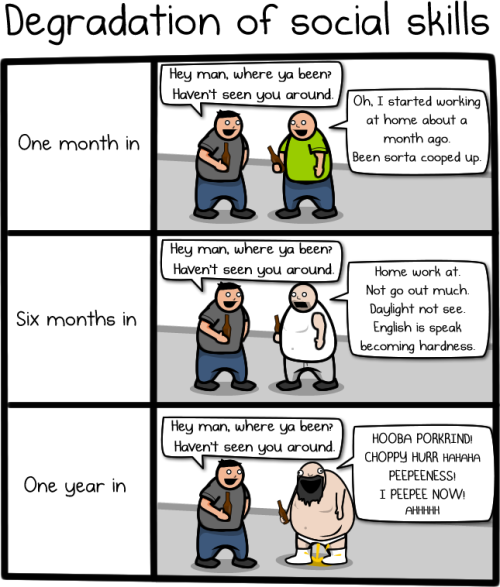How To Make Remote Work
When we moved to Poland I did not speak a lot of Polish. In fact, I still don’t, but that’s another story. I definitely was not close to the level where I could actually function in an office environment. When it came to finding a job there I had to ask myself: would a Polish software company hire a foreigner without any industrial experience who does not speak Polish? Also, would there be any interesting work for me in the city we decided to move to at all, or would I have to compromise?
I’m not a big risk aficionado, so I decided to preventively look around for alternative options. I found a company that had a most of their people work remotely all around Europe. It was an interesting company too, doing work closely related to my research topic. They were interested in me, and I in them. For our first in-person meeting they picked Amsterdam as location. “Hey, Cloud9 has their launch BBQ today, shall we go there?”
The rest is history.
From the get go I made clear at Cloud9 that I would have to work remotely. They were willing to accept that, but weren’t super enthusiastic. They had a few other people work remotely with varying degrees of success.
The first three weeks I worked for Cloud9 I spent in their office in Amsterdam. During this time I got to meet all the people, and spend a considerable amount of time with most of them. I felt this was going to be a key element of success: people should not forget about you as soon as you walk out the door and sign in from home. In addition, since a significant amount of communication would happen via text chat (Skype in this case), it was essential to know what the person is like when you’re talking to them: what their sense of humor is, for instance.
One of the remote people (in the US) would sometimes sign on to “the wall computer”. In the main room of the office, they had put up a big flatscreen with a webcam and mic attached to a Mac Mini. On the Mac Mini, Skype was setup to automatically pick up calls from contacts, allowing anybody remote to simply dial in and look and listen into the office, while the caller would appear full-screen.
This was an eye opener for me. Virtual presence in the office.
After three weeks it was time to make the move. “Later guys, on Monday I’ll appear on there.” I pointed to the display.
Challenges of working from home
I had never worked remotely much. We had work-from-home Mondays at my previous job, but I always found it hard to remain focussed during the day. It was so easy to get distracted and do a little bit of shopping, or a bit of YouTube watching and simply not get much done during such a day. When I was studying I had a similar problem when writing my master’s thesis. For a few months I basically had one task: write the thesis, and I’d do it from home. On the first day I got up at 7am, shower, eat breakfast and get to work. Next day, 7:30, then 8, 9, 10. At some point breakfast and lunch started to overlap and I realised this wouldn’t work. I had to create a schedule for myself and stick to it. I set myself daily goals and stuck to them, which eventually brought me back on track.
I was worried I would have similar problems when working remotely for months, perhaps years, full-time. How would I ever stay in the rhythm of the office. How would I avoid this:

Another thing that worried me was staying connected to the people, missing out on all chatter around the water cooler. I was very worried I would be left out of many things and be quietly forgotten.
This is why I liked the wall computer idea so much, and decided to be present as much as possible that way.
Consistent virtual presence
In the morning, when people started to come in to the office and switched on the lights, I would already be on the screen. “Good morning!”
I was on a Skype video call to the office always when I was working. The mic was good enough for me to hear the discussions in the back of the room, and speaker loud enough for me to participate. At first people were surprised to hear a voice coming from the wall, but over time it became business as usual. On Friday afternoons we would even have beers together; they had their tiny Dutch beers and I enjoyed a proper Polish sized-beer on my end.
Being on camera also helped me stay focused and on time. If I would be gone for hours during the day, people would notice. If I signed in later or left early, people would notice. It worked pretty well.
About half a year in, my role in the company changed. I was asked to lead the effort to stabilise the product, a job that eventually grew into the VP Engineering role.
This was a significant shift. Before I was hacking on Javascript code in a one-person team. Now, as it would turn out, I would spend most of my time collaborating with others; helping teams to get the things done that needed to get done. That’s more of a talking and meeting job than a hardcore hacking-by-myself job.
Nevertheless, in Amsterdam they did not consider the VP Engineering being remote as a problem. Clearly, they did not think of me as being remote, but as part of their office and did not see the physical distance (around a thousand kilometers) as an issue any longer.
How to talk to people from a distance
This new role did pose a few new challenges. Challenges related to my new responsibilities, but also at the I’m-remote-how-do-I-do-this level. As mentioned, I now had to talk to numerous people many times daily. With some people it was easy, they always had Skype on and would respond immediately when I’d send them a message. With others it was harder. They wouldn’t respond to chat messages at all, or with a big delay. They saw chat as a distraction from their work. Clearly, that wasn’t going to work for me.
I decided to solve this by using the remote equivalent of walking over to somebody and talking to them: I’d just give them a call. At first this was a last resort; later it became my default modus operandi for some people. People always notice being called, they don’t usually ignore that. So that worked out great. Voice calls are usually more effective than chat conversations anyway.
In some cases people would forget to switch on Skype. That was easy to solve as well, I’d just ask them “from the wall” to switch on their Skype, or if they were in another room, I asked somebody to go and ask them to switch on Skype. Simple.
Return often
To keep the connection strong with the office, every few months I’d plan a trip to Amsterdam. Usually, I’d stay there for a week or so. Every evening I would go out for dinner with one or more colleagues and spending most of the day time sitting next to people, discussing things, talking about personal stuff. If you’re there, use your time for stuff that is harder to do remote.
Tips
So, working remotely can work very well, even if you’re one of the few remote people in a company. Here’s some key take aways for me:
- Kick-off. To start things well, go there physically. Hang out with your colleagues for a few weeks. Get to know them. Figure out their sense of humor, this will turn out to be vital when the primary way of communication changes to plain text.
- Virtual presence. Be present, both via video and audio. A wall computer like the one in the Cloud9 office is not a big investment for a company, but can have a huge impact on relationship between local and remote people.
- Consistency. Be present always. That way you become part of the office rhythm and it will feel like you’re there, both for you and them.
- Find your communication medium. People use their tools differently. Make sure you always have a way to communicate with everybody at all times, don’t let it linger. Worst case: call people on their cell phone.
- Renew. Return to the office regularly. Meet with your colleagues in person. Use this time to compensate for the things that are hard to do when you’re remote.
- Be there when it matters. When times are tough, when important events/releases occur, be there physically. Jump on a plane, be part of it.
In most cases employers will prefer all employees to sit in the same office. However, it may be challenging to get the people to hire to move. They may not be willing to, or they may simply be incapable. Remote can work for this group and it can work very well. It does require good will, however, and a bit of investment. Do everything in your power to make remote people feel part of the group. Fly them in regularly. Organize a company trip with everybody once in a while.
My fondest memories of working at Cloud9 did not occur while I was physically at the office in Amsterdam; they happened a thousand kilometers away. Debugging a complicated problem with a few guys all night and finally finding the cause. Getting a Friday afternoon tour through the house and garden of another remote colleague as he took his laptop for a walk. Pippa, the office dog, jumping after toys thrown around by a colleague who before always claimed to be a dog hater.
I was there.

